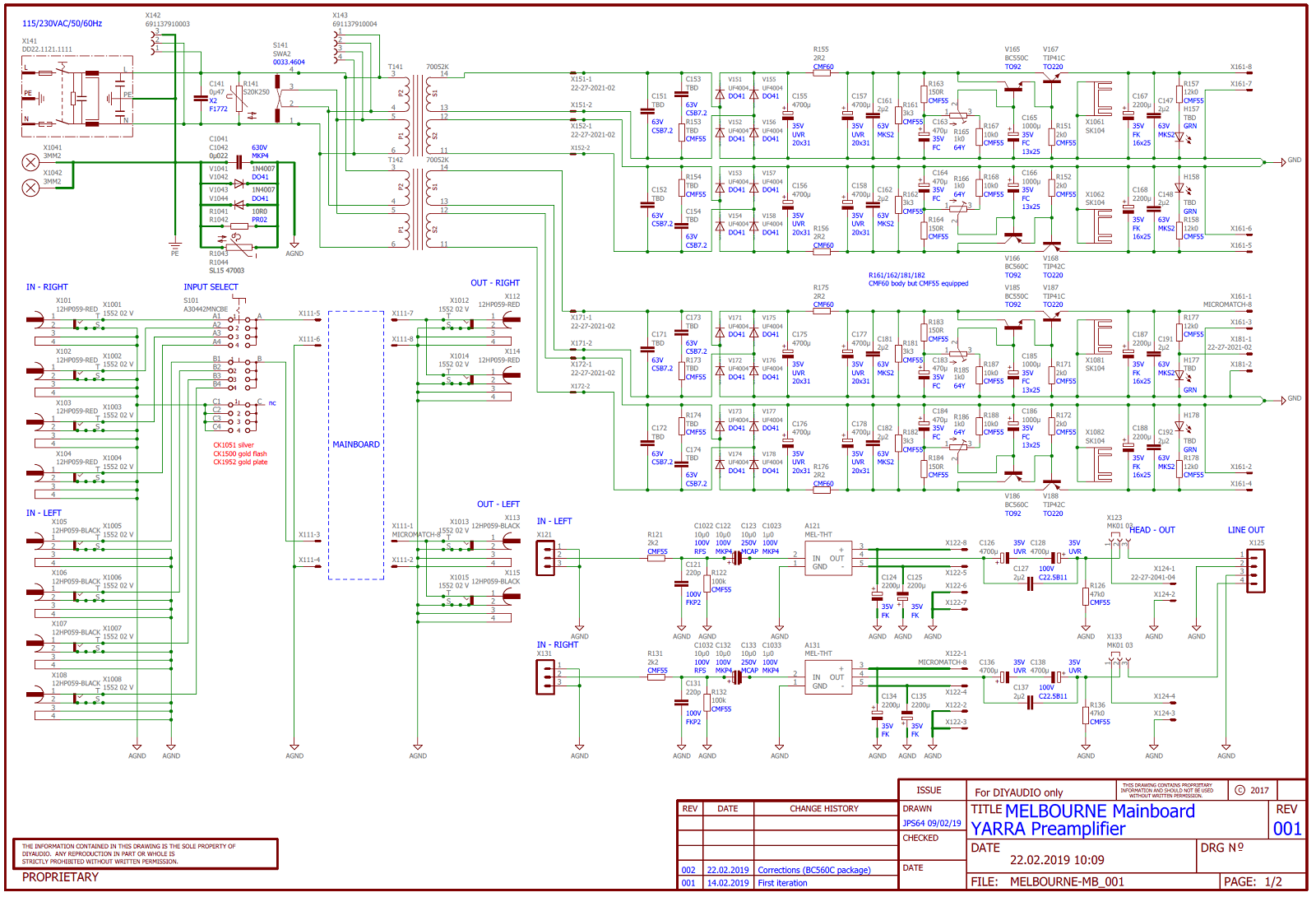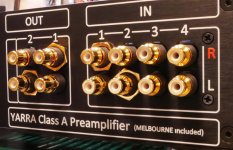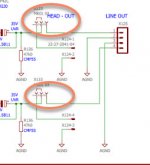I never did compare them side-by-side super critically, but the FO was first in my stable and I loved the sound it had. The V4H was my newest, but it sounded equally as good to my ears as the FO. It was a toss-up. I'm using an SMPS in the V4H. Due to some recent 'technical difficulties' however, the V4H needs to be repaired and hopefully put back into service soon. I will say the V4H was an easy build - including simple setup adjustments procedures. I'm still testing my Yarra pre with a recommended minor change applied.@redjr
Have you compared the FO to the V4H amp?
Thanks for your response. I thought that both of those amps would sound similar.
Sorry to hear about your amp. Hope you can fix it soon.
I have noticed that some commercial pre amps have a relay contact in series with the output and turn on after the power supply settles and turns off immediately after power down to avoid transients, DC etc.
Other preamps avoid the relay contacts and have a resistor in series with the output. A FET shorts the output to ground for a few seconds until "things" settle. I will do this for the preamp that I'm currently building and hopefully avoid blowing up a power amps.
Sorry to hear about your amp. Hope you can fix it soon.
I have noticed that some commercial pre amps have a relay contact in series with the output and turn on after the power supply settles and turns off immediately after power down to avoid transients, DC etc.
Other preamps avoid the relay contacts and have a resistor in series with the output. A FET shorts the output to ground for a few seconds until "things" settle. I will do this for the preamp that I'm currently building and hopefully avoid blowing up a power amps.
Change R126/136 from default 47k to 1k in order to reduce the output DC offset decay time when using cap coupled (not DC) output. Also, make sure you power the Yarra on first before the power amp. And when shutting down, power off the power amp first before the Yarra. This will prevent turn on/off transients from reaching your amp.
Okay noob question here, but can someone explain the coupling a bit more to me, like I'm a 10yr old? If I use the Yarra as both a HPA and a Pre, What coupling are we talking about and how can I identify the differences?
Also, C171-4 are TBD, is that because you don't know which transformer we are using? If that's the case, I'm using the 18v version. EDIT: I was looking at the schematic and it appears those are left off to measure the trans and determine snubber values?
JT
Okay noob question here, but can someone explain the coupling a bit more to me, like I'm a 10yr old? If I use the Yarra as both a HPA and a Pre, What coupling are we talking about and how can I identify the differences?
Also, C171-4 are TBD, is that because you don't know which transformer we are using? If that's the case, I'm using the 18v version. EDIT: I was looking at the schematic and it appears those are left off to measure the trans and determine snubber values?
JT
Last edited:
C126/128 and C136/138 are the 4700uF caps between the output stage and the output jack to the headphone. They are used to block DC in the event you use preamp modules like the PCA that cannot be DC coupled. When used with Melbourne it will block DC offset (minor 10mV to 50mV level). With Melbourne you can skip the coupling caps and DC couple.
Yes, those are snubbers and the exact value will depend on your particular transformer. I have found that 1uF and 180R works pretty well (checked with Quasimodo and an O-scope and for a particular Antek 3222). However, Vunce has told me his Antek 600VA 32v likes closer to ~10ohms.
You might consider adding those results to the thread about "In my testing on my Quasimodo, the optimum snubber for THIS transformer was..."
Quasimodo results (ONLY)
Quasimodo results (ONLY)
Talema 18v (70044)
Cs: 0.15uF
Cx: 0.01uF
Rs: 37R5
Yarra snubber location ID’s
Cs = C153,154,173,174
Cx = C151,152,171,172
Rs = R153,154,173,174
Vunce: Thanks again for the BOM also love that you have the location on the customer part number. IE pick a sleeve and it tells you where the part goes. Very nice that! They should, of course be verified, but this is awesome.
NOTE: The Mouser order BOM lists Rs = R153,154,173,174 as 51R1 you might want to pull that off, or come up with other as some people might not catch it. When I say some, I mean like me lol. I did catch it and didn't want to deal with removing resistors, so I just did a parallel to get me close at 38R. My target snubber, as above was actually 37R4. Just an FYI.
Mark/Jeff I will include this and another I in the, "Q-Only."
Cs: 0.15uF
Cx: 0.01uF
Rs: 37R5
Yarra snubber location ID’s
Cs = C153,154,173,174
Cx = C151,152,171,172
Rs = R153,154,173,174
Vunce: Thanks again for the BOM also love that you have the location on the customer part number. IE pick a sleeve and it tells you where the part goes. Very nice that! They should, of course be verified, but this is awesome.
NOTE: The Mouser order BOM lists Rs = R153,154,173,174 as 51R1 you might want to pull that off, or come up with other as some people might not catch it. When I say some, I mean like me lol. I did catch it and didn't want to deal with removing resistors, so I just did a parallel to get me close at 38R. My target snubber, as above was actually 37R4. Just an FYI.
Mark/Jeff I will include this and another I in the, "Q-Only."
Last edited:
Adding a Subwoofer?
Hi all,
Since my mishap earlier in the week, I continue (rather skittishly) to test the Yarra, and the influence it may have on my power amps. So far, the test have been positive as long as I observe the proper power up/down sequence.
As the Yarra does have two-sets of line-level outputs, I was planning on using the second set to go to a sub. I've been using a powered sub-woofer for years - most connected to the SUB-OUT on the rear panel of commercial preamps. Properly adjusted it adds the full dimension of the sound when paired with my Elacs Uni-Fi - UB5 speakers. The powered sub has its own line-level input, crossover and volume control.
So, during testing this morning, I hooked up my test sub to a single RCA channel on the 2nd set of pre-outputs. Powered everything up as it should be (no clicks or pops), and slowly adjusted the level of the sub. All I got was a continuous low-level hum roughly around 60Hz. No variation as the music was playing. I thought this odd. Seems like the process is simply adding another amp from the pre.
I first tested the 2nd set of output jacks with the main power amp and music played beautifully. So, thinking maybe the cable was at issue, I exchange it for a brand new sub cable I had in my shop. Still the same issue - low level continuous hum. I decided to try another sub, and got the same thing. I'm not trying to 'Y' the outputs together, or SUM them, just testing one of the RCA jacks for LF information.
So, what to make of this development? Can the 2nd set of pre outputs be used with a sub? Is there something simple I'm overlooking? My apologizes for all these seemingly basic questions.
Hi all,
Since my mishap earlier in the week, I continue (rather skittishly) to test the Yarra, and the influence it may have on my power amps. So far, the test have been positive as long as I observe the proper power up/down sequence.
As the Yarra does have two-sets of line-level outputs, I was planning on using the second set to go to a sub. I've been using a powered sub-woofer for years - most connected to the SUB-OUT on the rear panel of commercial preamps. Properly adjusted it adds the full dimension of the sound when paired with my Elacs Uni-Fi - UB5 speakers. The powered sub has its own line-level input, crossover and volume control.
So, during testing this morning, I hooked up my test sub to a single RCA channel on the 2nd set of pre-outputs. Powered everything up as it should be (no clicks or pops), and slowly adjusted the level of the sub. All I got was a continuous low-level hum roughly around 60Hz. No variation as the music was playing. I thought this odd. Seems like the process is simply adding another amp from the pre.
I first tested the 2nd set of output jacks with the main power amp and music played beautifully. So, thinking maybe the cable was at issue, I exchange it for a brand new sub cable I had in my shop. Still the same issue - low level continuous hum. I decided to try another sub, and got the same thing. I'm not trying to 'Y' the outputs together, or SUM them, just testing one of the RCA jacks for LF information.
So, what to make of this development? Can the 2nd set of pre outputs be used with a sub? Is there something simple I'm overlooking? My apologizes for all these seemingly basic questions.
Hi Redjr,
I never hooked mine up to the input/ouput selector PCB yet. I ams still running from an un-encsased PCB connected via an RCA jack connected to the headphone outputs (jumper pins 2-3 for X123 and X133). You will have to look at this schematic and tell me where you are connecting your power amp, and which is the "2nd set of jcks"?
The odd thing is you say that your main power amp plays music when you connect the 2nd set of RCA outputs.

Vunce has his fully wired so maybe he can hep.
I never hooked mine up to the input/ouput selector PCB yet. I ams still running from an un-encsased PCB connected via an RCA jack connected to the headphone outputs (jumper pins 2-3 for X123 and X133). You will have to look at this schematic and tell me where you are connecting your power amp, and which is the "2nd set of jcks"?
The odd thing is you say that your main power amp plays music when you connect the 2nd set of RCA outputs.
Vunce has his fully wired so maybe he can hep.
Change R126/136 from default 47k to 1k in order to reduce the output DC offset decay time when using cap coupled (not DC) output. Also, make sure you power the Yarra on first before the power amp. And when shutting down, power off the power amp first before the Yarra. This will prevent turn on/off transients from reaching your amp.
I'm still confused here... do we need to change R126/136 to 1k? The guy you said that to is using Melbourne I think you wanted him to change them, so what shall we do?
Might be time to do a build thread on this animal, there's info al over the place here. 6 build one of these things for us and do your thing.
This will be headphone and preamp.
JT
Thanks
C126/128 and C136/138 are the 4700uF caps between the output stage and the output jack to the headphone. They are used to block DC in the event you use preamp modules like the PCA that cannot be DC coupled. When used with Melbourne it will block DC offset (minor 10mV to 50mV level). With Melbourne you can skip the coupling caps and DC couple.
I'm still confused here... do we need to change R126/136 to 1k? The guy you said that to is using Melbourne I think you wanted him to change them, so what shall we do?
Might be time to do a build thread on this animal, there's info al over the place here. 6 build one of these things for us and do your thing.
This will be headphone and preamp.
JT
Thanks
@X
When looking at the back of the pre, outputs labeled #1, are closest to the 4 inputs. Since output set #2 play fine through my power amp too, I simply assumed they were wired in parallel with set #1.
Edit: Are you suggesting these 2 sets of outputs are in some way independent?
Edit 2: See oranges circles below. I thought these jumpers were for the addition of a headphone jack. Do they control outputs #2?
When looking at the back of the pre, outputs labeled #1, are closest to the 4 inputs. Since output set #2 play fine through my power amp too, I simply assumed they were wired in parallel with set #1.
Edit: Are you suggesting these 2 sets of outputs are in some way independent?
Edit 2: See oranges circles below. I thought these jumpers were for the addition of a headphone jack. Do they control outputs #2?
Attachments
Last edited:
@X
Just to be clear, my pre is outputting the selected source through both sets of outputs, #1 and #2.
EDIT: Yes, that's my take. Do a sanity check and unplug the speakers and plug the sub in to one set and the other... does it work?
Removed verbiage to let someone with more knowledge take the lead.
Last edited:
Change R126/136 from default 47k to 1k in order to reduce the output DC offset decay time when using cap coupled (not DC) output. Also, make sure you power the Yarra on first before the power amp. And when shutting down, power off the power amp first before the Yarra. This will prevent turn on/off transients from reaching your amp.
I'm still confused here... do we need to change R126/136 to 1k? The guy you said that to is using Melbourne I think you wanted him to change them, so what shall we do?
If using as a preamp only, you can change cap to 47uF and leave 47k.
If headphone and preamp, leave big dual 4700uF caps and change to new R from 680R to 1k. You could go to smaller single 2200uF bipolar cap too. The large cap value is to provide bass extension for lower impedance headphones.
- Home
- Group Buys
- The YARRA Preamplifier/HPA for Melbourne DB Group Buy

